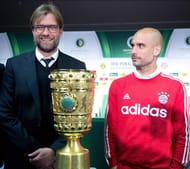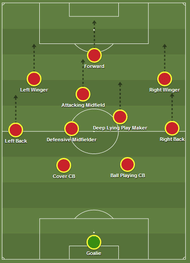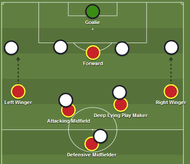The primary objective in football is to score goals. How do you score goals? Well it’s mostly by you having possession of the ball and creating a goal-scoring chance. Either you have possession of the ball and try to score a goal, or the opposition has possession of the ball and you aim to regain possession while simultaneously not conceding a goal. So football is basically a game of how you use possession on the ball and how you react without it.
Right now in football, the two main things teams do without the ball are:
- Pressing the opposition to quickly regain the ball.
- Quickly transitioning to a deep defence, to prevent a counter attack.
In this article, we will talk about the first facet – how does a high pressing approach without the ball work in football.
A high pressing approach off the ball has been used by possession-hungry sides like Barcelona, Spain, Roma (Totti and the 4-6-0) and recently Bayern Munich under Pep Guardiola. This system relies on brilliant ball retention and all teammates being able to keep the ball and pass it around. However, the best part is how they work off the ball. As soon as they lose the ball, they start pressing at an incredible intensity to win the ball back.
Tika-taka as it is called, is patiently probing with the ball and looking for an opening, but furiously winning it back if it’s lost. Recently however, we have seen high-pressing without having Barcelona like possession of the ball. Chile have been the masters of this, while Real Madrid and Borussia Dortmund have found success replicating a high-pressing approach, but being far more direct on the ball. The term gegenpressing is given to Dortmund’s approach which won hearts and results in Bundesliga and DFP Pokal glory along with a Champions League final.
First of all, we will have a look into the formation of a high-pressing system. The formation here is a 4-2-3-1 (the most-used formation nowadays) but it can be easily reverted to a 4-3-3 with the attacking midfielder dropping deeper. The formation requires all 11 players to press, and only at top sides like Real Madrid can a compromise of one player’s lack of defensive work-rate be reached.
A high pressing system requires pressing as a team from the entire 11 and they should know exactly what their roles are and when to press. This starts from the forwards and their positioning when the ball is with the goalkeeper or the centre-backs all the way to the goalkeeper sweeping behind the defence. We will first look at how teams press opposition defenders and attempt to stop the attack before it begins.
Stopping the attack before it begins
The forwards aim to press the centre-backs and not allowing them a easy pass into the midfielders. Nowadays in the world of single-striker formations, forwards usually take a place between the centrebacks, attempting to stop any passing between the center-backs. The attacking midfielder and the deep lying playmaker in turn push up and cut off passing lanes to midfielders.
The wingers in turn stay just a touch away from the fullbacks. What this does is that while they look free of pressure, the moment they touch the ball there is a winger pressing them. The attacking midfielder or the fullback can charge towards this side to create a 2 v 1 overload and win the ball.
The striker’s positioning is key here. If he is positioned perfectly, the centreback will either have to hit a long ball to a striker, a pass to the nearby fullback (right centreback to right back OR left centreback to left back) or will have to play it back to the keeper. If he attempts to switch play to the other side, usually he won’t have time to look up and measure his pass and this can lead to a misplaced pass.
A pass back to the keeper means that the striker does the same of what he did before the centrebacks had the ball, a pass to the fullback is where the teams wants the ball to be (more on that later) while a long ball has a 50/50 for either side and it usually results in the defending side winning the ball.
Thus, just by cutting off passing lanes, the strikers and midfielders have ensured that the ball goes to the fullback or goes and thus they have forced the opposition to pass the ball where they want them.
Once the ball goes to the fullbacks, the side aims to overload that side of the pitch. If the ball goes to the rightback, he will have a few seconds to think about where to pass before the winger breathes down his neck. The attacking midfielder will look to have a two on one against him to force him into a mistake. To fill this vacated space, the deep lying playmaker and the right winger tuck inside.
This keeps the numerical advantage and gives less room to the opposition. The leftback is completely out of the attack now and thus the team can ignore him and focus on compressing space for the rightback.
The defence pushes up to minimize space for the midfielders (more on that later) and thus the rightback has to either pass the ball an already marked central midfielder in hope he can make a move, deliver an inch-perfect long ball which is unlikely given the pressure he is under and that rightbacks aren’t great players techincally usually or pass it back to the goalkeeper.
If the fullback is a good player on the ball, then these are a few steps the side can take to stop his influence:
- The winger marks him tightly to not give him any time on the ball.
- The striker presses to make sure the ball doesn’t reach him. For example, if the leftback is a good player, the striker and right winger press the left centreback and the left back, forcing the keeper to pass the ball down the right side. Teams have frequently used this tactic against Chelsea’s Branislav Ivanovic who isn’t a great player on the ball.
By pressing from the front, teams cannot build attacks from the back and thus are usually forced to move the ball forward. All this requires a lot of training ground practice and awareness of how your teammates play. Everyone should know their role when the fullback touches the ball and how to press, one guy losing his concentration can lead to the opposition passing around him and evading this first line of pressure.
Pressing in midfield
While pressing from the front stops a lot of attacks, there will be times where the midfielders will get the ball. When that happens, their attempt will be to get the ball to the forward players are quickly as possible. The first way to stop this is to keep their back to goal, they can’t see the forwards that way. If you are pressing them with their back to goal, you will very rarely get turned (provided the other players close down the passing lanes) and this results usually in a turnover.
Along with that, teams just get in the faces of the opposition and cut off passing lanes. The midfielder is in the same dilemma as the defenders here about whether to dribble/pass forward and risk a turnover or pass the ball back and break down the move. The most important part to consider here is that the defenders and midfielders have only a second or two to think this before the ball is taken off them and thus finding the right pass isn’t easy.
An important phase of midfield is organization. As the team loses the ball, they press ferociously to win it back. However, if the opposition keep the ball for some 10 seconds, they quickly drop back into their standard formation. The quickness of this defensive transition is what decides whether they will be counterattacked or not. Once they have retreated to their normal shape, the situation restarts. If the ball is with the defenders, the first wave of pressure starts. If the ball by the time reaches in the midfield, the pressure starts.
Barcelona and Borussia Dortmund’s pressing has been the shining example of this. Barcelona under Guardiola employed a six second rule. The closest 2-3 players press full-on to regain possession while the rest of the team gradually shift to their side as a backup. The team usually forced a mistake or a longball in these six seconds and regained the ball. If not, they quickly get back to a organized formation, conceding space. The formation looks like an English 4-4-2 mostly.
Once back into position, they look for triggers to start their pressing. Like, the ball towards the right-back is a trigger of the left winger to begin the pressing. The left-winger’s pressing is a trigger for the attacking midfielder and the rest of the team of what is their role in this pressing.
The high defensive line
It’s not like the defence has no role in this. Infact, one would argue that their positioning is what makes this pressing work. To minimize space in between the lines, the defence pushes up. If the defence stays deep and the forwards press forward, then there is a lot of space in the middle of the park and all the keeper needs to do is knock the ball over the first line of pressure.
Once past, they will have some 50-60 yards between the attack and defence of freedom with only one or two midfielders who can easily be overloaded and beaten, As such, to stop the space here, the defensive line pushes up. This in turn allows the midfield and forwards to advance forward and pushes the opposition back into their own half. This exposes a gap between the keeper and the defense however and a perfectly timed pass and run (RvP’s goal against Spain) can often undo the good work.
To stop this, the centrebacks need to be pacy and good on the ball so that they can run on the turn while the keeper needs to be quick and good on the ball to advance forward and sweep up any loose balls (Manuel Neuer and Hugo Lloris are brilliant in this regard). The highline also compresses space for the opposition, as both defences are barely 40 yards apart.
The problems in a high pressing system
No system is perfect and every system has its flaws and weakness. With that in mind, we dissect the major problems in the high defensive line pressing system.
- Tiredness: The biggest problem in this system. It takes a lot of running and energy to sustain this pressing for 90 minutes. Usually teams press ferociously for 60 minutes and get a 1-2 goal lead before going deep as they tire out. It’s not a system for old legs, players who are lazy and don’t do much defensively, no matter how good they are.
- Disjointed Pressing: If one player neglects his defensive responsibilities, it could be catastrophic for the entire system. Indeed, one of the major problems for Spain this World Cup was that Xavi and Xabi Alonso simply didn’t have the legs to press with a high tempo (Spain’s best spell in the first two games came between the Alonso penalty and van Persie goal, where they could afford to sit back). We have already covered what happens if the defence doesn’t press and push up. Alternatively, if the attack doesn’t do its duties, the midfield has ample time to wait and pick out a pass over the top of the defence for a pacy attacker – time that should not be allowed in a high pressing system.
- Facing a good team: A good team, which can keep the ball and stretch the opposition, can stand up to a high pressing system. The can keep the opposition moving and tire them out before striking. This has been a problem of teams trying to have a high pressing system against teams like Barcelona – their superior ball retention and movement of the ball makes them overpower the opposition.
A high-pressing approach has been the approach used by arguably the greatest side ever seen in the world in recent times – Barcelona. Bayern Munich (Heynckes) and Borussia Dortmund’s styles – although different – have been also a type of a high-pressing system. Its a joy to watch, but it requires tons of practice off the pitch and brilliant mental concentration on it.
Along with that, it requires all 11 players to be good on the ball and being able to win the ball back. It requires a lot of stamina for the players to last this for 90 minutes and it can backfire on teams that tire out. Thus, many teams alternate by pressing ferociously initially before gradually tiring out and playing deeper late on. While we admire the brilliant passing and attacking flair in Barcelona and Borussia Dortmund, equally impressive is their work off the ball to make sure they keep the ball and create those chances.




